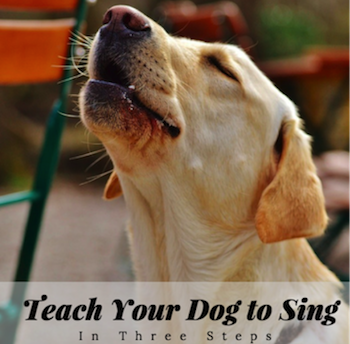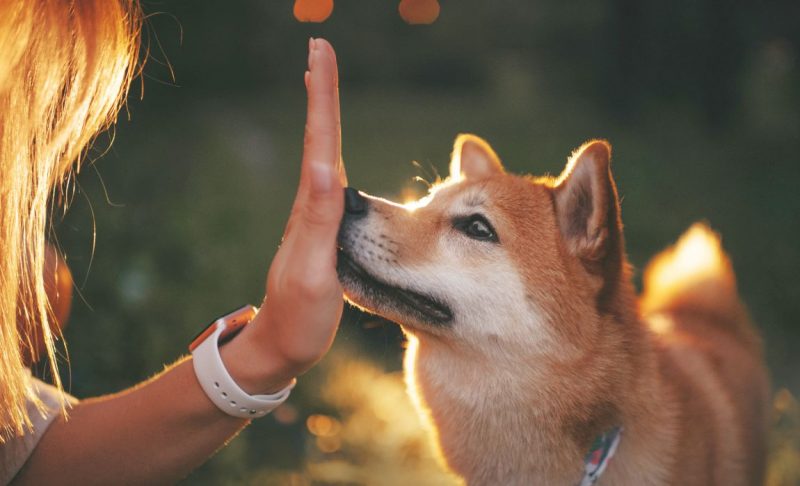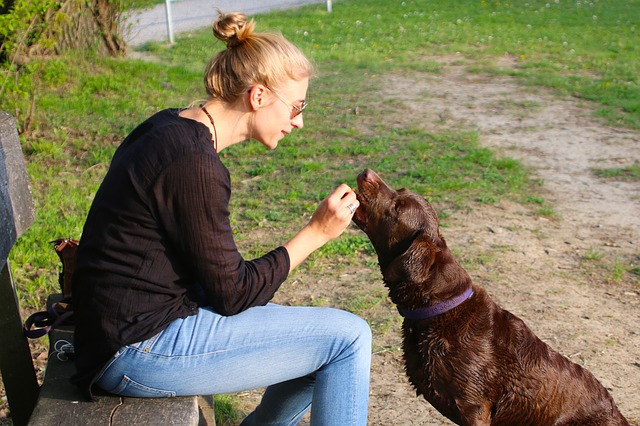
Teaching a vocal dog how to howl on command or sing on cue generally isn’t very difficult. However, if your dog isn’t naturally very vocal, this trick can pose a challenge!
We’ll go over the step-by-step process of teaching your dog to sing or howl on cue. Eat your heart out, Cranberries.
For a vocal dog that already likes to make noise, your main job for this trick is two-pronged. You must learn how to reward your favorite howl, and then you need to put it on cue.
That’s really it! The only addition step will be if your dog isn’t a big talker, in which case you’ll need to add in the extra step of figuring out how to get your dog to make noise! We’ll go over tips for that later.
If you are the proud owner of a husky, you’re in luck! Huskies are a breed famous for their singing abilities. Just check out YouTube sensation Mishka (who has a pretty impressive 800,000 followers – good dog!)
General Trick Training Tips: What to Know Before You Start
Teaching your dog to sing don’t just mean repeating the singing cue until the dog complies.
Remember that your dog does not speak English, Spanish, or Thai. You need to show your dog what you want him to do.
Research suggests the best way to do this is via positive-reinforcement based training. Before we even start getting into the nuts and bolts of training, let’s go over some general training guidelines.
These guidelines are helpful no matter if you’re training a dog to sit, sing, or be a seeing eye dog.
Keep your dog’s attention span in mind. Long training sessions wear your dog’s brain out, so keep training sessions around 5-10 minutes. I like to block off an hour for training my dog – but we don’t just train straight for an hour. We intersperse training with petting, bouts of play, or short walks. It’s just an hour of owner-dog bonding time!

If your dog is having a hard time, try to break the training down into even smaller steps. I suggest writing down every movement that needs to happen in order for a dog to complete a task.
For example, when working on “come,” I might start with rewarding a dog for just swiveling her ears towards me, then looking at me, then turning towards me. You get the picture.
In this vein, it helps to think of behaviors under the framework of math. Rewarding a dog for a howl is like learning to add. Teaching a dog to sing on cue is like learning basic algebra. Cueing a dog to sing when you’re at a music festival full of strange sounds, smells, and people in costumes is like performing calculus during a college admission test!
Every step is a building block that depends on the foundation of the last skill. Don’t push your dog too hard or too fast – make sure you’re working off of a solid foundation before moving forward.
Always End On An Easy Win. Training can be frustrating for dogs, even when we try to keep it fun. No one likes failing, even Fido. If your dog is really struggling or even slipping backwards in training, take a step back. You can cue your dog to do something she knows how to do already (sit or down) to give her an easy win. Ending your training session on a win will make your dog more likely to look forward to the next session!
Keep it Fun! Trick training is challenging but should be fun for you and your dog. Don’t punish your dog for making a mistake. When I get frustrated in training sessions, I take a break to play tug, fetch, or walk around the block. If I can see my dog is getting frustrated, we do the same. I can tell she’s getting frustrated if she starts barking at me, takes treats from my fingers a bit harder than normal, or starts getting a glazed-over look in her eyes. The goal is to change things up before you hit these signs of frustration!
3 Steps To Teaching Your Dog To Sing On Cue
This behavior’s difficulty really depends on your dog. Some vocal huskies will likely pick this up no problem (they’re also pretty good at the “I love you” trick), while a quiet whippet may really struggle. Keep these realities in mind and be sure to remember your basic training guidelines from above.
Normally I’m a huge advocate of clicker training, but in this case, I’ve found that praise and attention actually work very well. Let’s get started on the steps needed to teach your dog to sing!
Step #1: Capture the Behavior
Unlike parrots, most dogs aren’t natural mimickers. That means your best bet for success is to try to “capture” and “shape” a vocalization that resembles your end goal. This is different from how I teach my parrot to talk, because my parrot naturally seems to enjoy mimicking the sounds I make, while my dog will just look at me like I’m crazy when I start belting out Taylor Swift!
That said, some dogs will join in with a singing or howling human, so it’s worth a shot!

If you’re attempting to train your dog to sing or howl on command, odds are your dog already occasionally howls. Try to think of when your dog already makes a sound similar to your end goal. Maybe it’s when your pooch wants to go outside, or when you break out a beloved squeaky toy. Coming up with a definition of your end goal sound is a solid idea here.
Since our goal is capturing this behavior, let’s talk about some times that dogs may make sounds similar to singing. You can try to set up these situations in order to expedite the process. Otherwise you might sit around with a bag of treats forever waiting for your dog to sing!
- When certain music plays
- When sirens go by
- When you howl or sing
- When they’re hungry (please don’t starve your dog)
- When they’re excited
- When another dog barks or howls (try YouTube recordings)
When you’ve gotten your dog to howl, sing, or make a sound that resembles your end goal, make sure to have plentiful training treats on hand to reward her with – be it liver, milkbones, hot dogs, or other rewards like praise, tug-of-war sessions, and cuddles.
Pro Tip: In order for it to be a reward, your dog must like the consequence. Many dogs don’t like being hugged, but love getting scratched on the ears or butt. I’ve found many dogs that are social howlers also enjoy verbal praise. Switching up the rewards is actually a great way to keep your dog engaged.
When your dog gets it right, really go nuts for your first success! As you repeat this exercise, your dog should realize that howling gets her a reward. She’ll howl more often in order to work for the reward.
You may suddenly be hearing a LOT of this…warning, this video is insanely cute, so prepare yourself.
Step 2: Shape the Behavior
Once your dog is howling up a storm, you’ll want to shape that howl into your ideal desirable behavior. Maybe you want a longer howl, or shorter. Maybe you want high-pitched or low-pitched. Shaping the behavior is the act of taking something your dog is already doing (howling) and turning it into the finished end product.
Think about your end goal. Do you just want your dog to howl on cue? Then you might be ready to go straight to Step 3. But if you’ve got a more specific goal, you’ll need to start being pickier about which howls you reward. This process can feel slow and imprecise, so it’s key to have a defined goal of what you want your dog’s song to sound like.
If your goal is a two-toned howl at least 10 seconds long, start by rewarding two-toned howls instead of one-toned howls. Your dog should eventually catch on and start offering those two-toned howls more often.
Once the two-toned howls have been mastered, you can start rewarding the more drawn-out howls instead of the shorter ones. If your reward is a good one, it won’t take your dog long to get the hang of the game and start improving their howl in order to earn the goodies!
Step 3: Select and Install the Cue
At this stage, your dog might be howling at random and praying he’ll get a treat. Or perhaps you’ve already started to “install” a cue instinctively. If your dog only howls when you play a chord on the piano, congrats – you’ve already installed a cue (and possibly didn’t even realize it, you training pro you).
If that’s been your approach, you’ve got a head start. You can just leave the chord on your piano as the cue. If you howl and then your dog joins in, that works too. But if you want your dog to sing on a different cue, like “Sing with me, Fido,” then we’ve got this one final step left.
Pick out your cue, then start to say the cue right before your dog howls. Add in your chosen cue several times – there’s no magic number. The key is to eventually start only rewarding your dog for singing if you gave the cue before they howled. If you didn’t ask for the behavior, they don’t get rewarded for doing it. This part is important to avoid training your dog to howl all the time – like when you’re on the phone or at 2am!
***
That’s it! Hopefully by following these steps, you now have a dog that will sing or howl on command.
If your dog is extremely quiet and simply isn’t destined for the recording studio, you can try to think of other cute tricks that are related. I know a quiet lab mix that flings her head back on cue, as if she’s howling, but makes no noise. It’s adorable!
Does your dog sing or howl on command? Are you stuck on a certain part of this protocol? We want to hear from you!








Leave a Comment